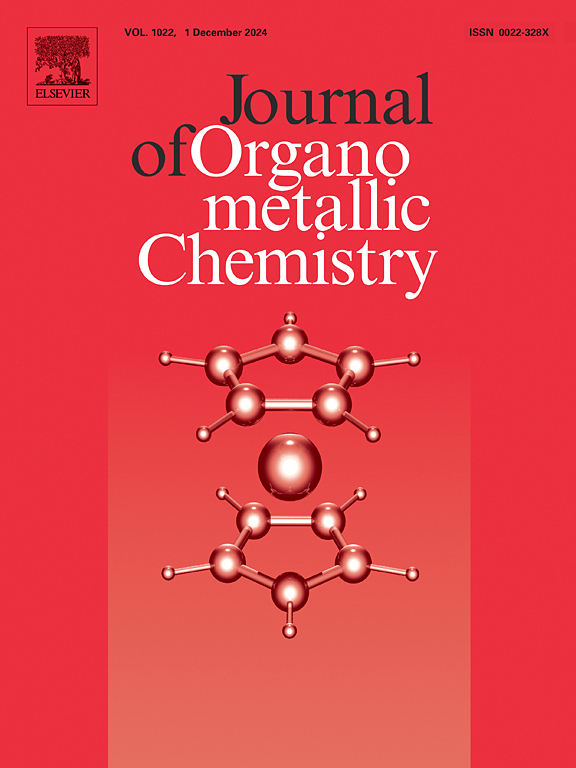Fe3O4@SiO2-Diol/AQ-Pd(0)纳米复合材料通过三组分硫代羰基化偶联反应催化硫代酯的生态友好合成
IF 2.1
3区 化学
Q3 CHEMISTRY, INORGANIC & NUCLEAR
引用次数: 0
摘要
在这项工作中,我们报道了一种新型Fe3O4@SiO2-Diol/AQ-Pd(0)纳米复合催化剂的开发,用于通过一锅三组分硫代羰基偶联反应环保型合成硫酯。该方法以Mo(CO)6为固体羰基源,通过芳基碘化物和芳基硫醇反应,高效地合成了硫酯。纳米复合催化剂可以简单地回收,重复使用,并利用多达8个循环,而不会降低该催化系统的有效性,从而最大限度地减少对环境的影响。该催化剂采用简单、温和的方法合成,其结构经多种分析技术验证。SEM和TEM分析证实了纳米颗粒的球形和纳米尺寸,XRD和VSM分析证实了它们的结构完整性和强磁性。我们的方案表现出显著的官能团耐受性,并在温和的反应条件下提供高的硫酯收率(82 - 98%)。更重要的是,我们的方法通过消除对气态一氧化碳的需求,提高了催化过程的安全性和可持续性,使科学界放心,我们致力于负责任的研究。这种方法代表了绿色合成硫酯的重大进步,并强调了磁性纳米复合材料在催化方面的潜力。这些发现为进一步研究可持续的催化系统提供了令人兴奋的途径,旨在减少有机合成中的环境负担。本文章由计算机程序翻译,如有差异,请以英文原文为准。

Fe3O4@SiO2-Diol/AQ-Pd(0) nanocomposite catalyzed ecofriendly synthesis of thioesters via three-component thiocarbonylation-coupling reactions
In this work, we report the development of a novel Fe3O4@SiO2-Diol/AQ-Pd(0) nanocomposite catalyst for the eco-friendly synthesis of thioesters via a one-pot, three-component thiocarbonylation-coupling reaction. This method efficiently synthesizes thioesters by reacting aryl iodides and aryl thiols, using Mo(CO)6 as a solid carbonyl source. The nanocomposite catalyst can be simply recovered, reused, and utilized for up to 8 cycles without decreasing the effectiveness of this catalytic system, thereby minimizing environmental impact. The catalyst was synthesized through a simple, mild method, with its structure validated by various analytical techniques. SEM and TEM analyses confirmed the nanoparticles' spherical shape and nanometer size, while XRD and VSM analyses ensured their structural integrity and strong magnetic properties. Our protocol exhibits remarkable functional group tolerance and delivers high yields of thioesters (82–98 %) under mild reaction conditions. More importantly, our approach enhances safety and sustainability in catalytic processes by eliminating the need for gaseous carbon monoxide, reassuring the scientific community of our commitment to responsible research. This methodology represents a significant advancement in the green synthesis of thioesters and underscores the potential of magnetic nanocomposites in catalysis. These findings suggest exciting avenues for further research into sustainable catalytic systems aimed at reducing environmental burdens in organic synthesis.
求助全文
通过发布文献求助,成功后即可免费获取论文全文。
去求助
来源期刊

Journal of Organometallic Chemistry
化学-无机化学与核化学
CiteScore
4.40
自引率
8.70%
发文量
221
审稿时长
36 days
期刊介绍:
The Journal of Organometallic Chemistry targets original papers dealing with theoretical aspects, structural chemistry, synthesis, physical and chemical properties (including reaction mechanisms), and practical applications of organometallic compounds.
Organometallic compounds are defined as compounds that contain metal - carbon bonds. The term metal includes all alkali and alkaline earth metals, all transition metals and the lanthanides and actinides in the Periodic Table. Metalloids including the elements in Group 13 and the heavier members of the Groups 14 - 16 are also included. The term chemistry includes syntheses, characterizations and reaction chemistry of all such compounds. Research reports based on use of organometallic complexes in bioorganometallic chemistry, medicine, material sciences, homogeneous catalysis and energy conversion are also welcome.
The scope of the journal has been enlarged to encompass important research on organometallic complexes in bioorganometallic chemistry and material sciences, and of heavier main group elements in organometallic chemistry. The journal also publishes review articles, short communications and notes.
 求助内容:
求助内容: 应助结果提醒方式:
应助结果提醒方式:


